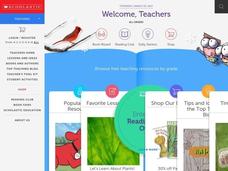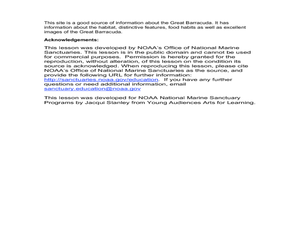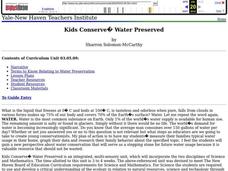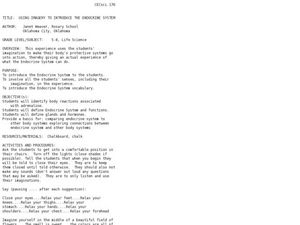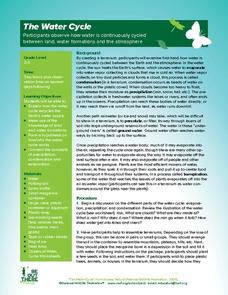Curated OER
Weather Watchers
Second graders discuss what weather is and list words that can be used to describe weather. In this science lesson, 2nd graders develop symbols for each type of weather and record the weather for two weeks at the same time and the same...
Curated OER
Evaporation
Fourth graders study the water cycle and the different processes involved, specifically evaporation. They explore the processes of evaporation through hands-on collaborative activities and relate learning to life through...
Curated OER
Climate And the Greenhouse Effect
Students demonstrate the greenhouse effect. They recognize that relatively small changes to our environment can stimulate significant climate changes. They determine that the "scientific method" is a process of testing hypotheses and...
Curated OER
Energy Woes
Students role play as members of Save the Earth Foundation attending a public hearing about potential energy failures. They write a plan of action regarding the advantages an disadvantages of alternative energy sources.
Curated OER
What's Up?
Students examine the vocabulary and objects associated with objects in the sky and weather. They observe the sky outside of their classroom and create a list of things in the sky. Students then analyze a poster, read and discuss key...
Curated OER
What is Weather?
Students identify different types of weather and explore the weather for each season of the year. They complete a class seasonal weather chart, listen to the book "Oh Say Can You Say What's the Weather Today?," and create a magazine...
Curated OER
Extreme Weather
Students examine different types of extreme weather and how to prepare for them. In this weather lesson plan students explore different types of extreme weather and create disaster preparation posters for different types of extreme weather.
Curated OER
Gettysburg Rocks Recycle to Win
Eighth graders use a geologic cross section to study the rock cycle of the Gettysburg battlefield. In this rock cycle lesson, 8th graders connect the rock cycle and continental rifting.
Curated OER
Splish, Splash Poetry
Students write weather shape poems and sing weather related songs. In this creative writing activity, students read the book, It's Raining, It's Pouring and list weather words they heard in the story. Students use the writing process to...
Curated OER
The Great Barracuda
Young scholars explore oceanography by researching the great barracuda. In this animal life lesson plan, students read several vocabulary terms dealing with ocean life and examine a drawing of a barracuda. Young scholars examine the...
Curated OER
Water
Students conduct a series of investigations on the unique properties of water. In this general science lesson, students explain what causes water's surface tension. They explain the different stages in the water cycle.
Curated OER
Kids Conserve? Water Preserved
Students study conservation and how cities obtain their water. In this water instructional activity students view a PowerPoint presentation and draw a picture of the water cycle.
Curated OER
Using Imaginary to Introduce the Endocrine System
Students examine the functions of the endocrine system. In this body protective systems lesson students identify body reactions, define terms and complete an activity.
Curated OER
Let's Think About Water
Students explore the different forms that water can take and conduct simple experiments to demonstrate some of its properties in each state. They watch a short video that illustrates some of these concepts.
Curated OER
Critical Thinking & Writing: Brainstorming
Have your young writers organize their thoughts before writing. They generate ideas through various brainstorming activities prior to writing a mock feature news story for USA Today. A series of USA Today articles debating the level of...
Curated OER
The Water Cycle
Learners are introduced to the components and importance of the water cycle. They are shown how groundwater moves using a model. Students list 9 places on earth where water is found. They define the terms cycle and water cycle.
Curated OER
Finger Painting and Feather Painting with Nature
Students explore finger painting and painting with feathers and recreate the look of objects in nature. They read the book, 'It Looked Like Spilt Milk,' create a shaving cream print, paint with feathers, and construct a mirror image on...
Curated OER
Weaving Project
Students practice artistic weaving. In this Colonial arts lesson, students weave pieces using lint from their home dryers. Students replicate the weaving process early Americans used. Students are also challenged to weave using the extra...
Curated OER
Lightning
Students study lightening and the history behind how it was used for electricity. In this electricity lesson plan students complete several experiments on the invention of the lightning rod.
Curated OER
Howwwwl At The Moon
Students explore vowel digraphs. They discuss what a vowel digraph is and discuss the vowel digraph ou=/ow/. Students read "The Napping House." They practice spelling words with the /ow/ sound in them. Students read words with the /ow/...
Curated OER
If I Were A Raindrop!
Students review the water cycle. In this water cycle lesson, students review the different stages of the water cycle. Students use the computer program Kid Pix Weather to help demonstrate understanding.
Curated OER
Ripped Paper Art - Snowmen, Mountains and Evergreens
Students discover depth in photographs or paintings by creating a picture from scrap paper. In this art analysis lesson, students practice creating depth by placing different elements higher or lower on a picture. Students utilize torn...
Curated OER
Settling Down in a New Country
Young scholars explore environments by researching foreign countries. In this immigration lesson, students complete worksheets describing the many steps needed for an immigrant to become a citizen in a new country. Young scholars...
Curated OER
Using Radiosonde Data From a Weather Balloon Launch
Student use radiosonde data from a weather balloon launch to distinguish the characteristics of the lower atmosphere. They learn the layers of the atmosphere. They graph real atmospheric data.






